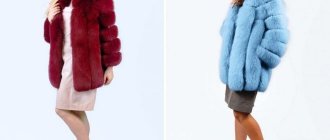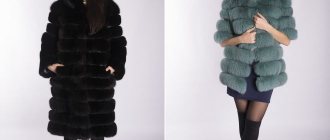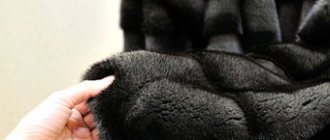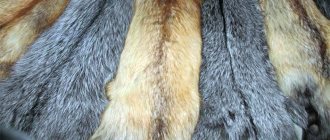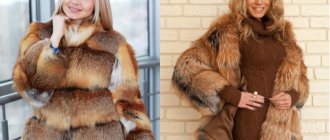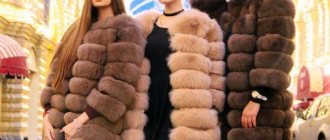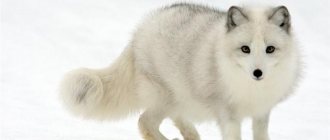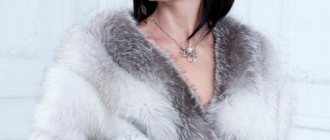Just a few decades ago, every woman in the country dreamed of a lush arctic fox fur coat. It’s not surprising, because arctic fox fur coats were considered in those days a real sign of prosperity and good taste. And the fact that products made from this animal were also very warm was perceived by default.
Choosing Arctic fox fur coats
Original models of arctic fox coats
Nowadays, fur coats made from northern animals are no less popular, thanks to the original ideas of designers who use new techniques in creating their models. Now arctic fox fur is not used exclusively in its original form, but various tricks are used to give it a more sophisticated look:
- paint;
- cut;
- laser engraved;
- combined with other analogues;
- stitched horizontally in strips.
The original transverse arctic fox fur coat, extremely popular in the 2015-2016 season, is obvious proof of the success of such experiments. To sew a fur coat from an arctic fox, as can be seen in the photo, strips of different widths are used, which are then sewn together. Quite often, transverse stripes are additionally trimmed at various levels and combined with leather, which accentuates the unusual style of the product and provokes admiring reviews.
What types of Arctic fox counterfeits are there?
Most often, expensive fur is counterfeited. They are trying to replace it with cheaper skins:
- Sometimes they try to pass off the fur of one animal as another. The most common fake is mink. After simple manipulations, the fur of a rabbit or arctic fox takes on a look similar to mink;
- Fur pelts are sorted before they go into production. The highest quality and most expensive ones are used to manufacture luxury products.
Unscrupulous manufacturers are trying to improve the appearance of rejected fur and make it look like it is of high quality. In this case, the fur will be natural, but the cost of the product will be much higher.
It is almost impossible to replace the arctic fox with the fur of another animal, since it has a fairly long and fluffy pile. Therefore, it is replaced with synthetic materials. Faux fur is preferred by animal rights activists, and such products are also purchased by those who cannot afford a natural fur coat.
Play of shades on products
It is noteworthy that arctic fox skins can be dyed using the latest technologies, which eliminate color loss even after intensive wear. Similar models from the catalog are chosen mainly by young, active women who prefer originality to classics.
Short coats made of arctic fox fur with a hood, created from 2-3 similar or contrasting shades, are perceived as extraordinary. During sewing, the skins can be positioned vertically, which allows the uncut hairs to fall beautifully, or horizontally. Fur coats of this type are very popular with women who can wear their size without worrying that lush fur will make them look fat.
Previously, fur-bearing animals were shot in the wild, and the skins obtained in this way were used for sewing clothes. Now, due to the general availability of fur products and the great demand for them, arctic foxes are bred on specialized farms, where through selection it is possible to obtain amazing furs with various shades:
- grayish;
- blue;
- silver;
- dairy
Naturally, the snow-white classic color of the Arctic fox is no less in demand, especially in combination with other furs.
How and with what to wear a fox fur coat
- The splendor of the fur suggests sewing products of simple styles. Designers prefer to create things with a straight or trapezoidal silhouette. The fur itself looks rich, unnecessary details make the thing bulky.
- It is difficult for even fragile girls to look slim in such a fur coat. But you shouldn’t give up luxury products for this reason.
- Fashion designers recommend that fashion designers wear the fur of other animals, using fox trim.
- Products with inserts, the so-called combined fur coats, are very fashionable. For example, the cuffs, hood or collar are made of fluffy fur, the fur coat itself is made of mink. Fur products made from astrakhan fur, trimmed with arctic fox, look inimitable.
- Turn-down collars and stand-up collars are constantly in trend. The hoods were a great addition. The round neckline also looks modern.
- Not a single fashionista will refuse, for example, a fur coat made of black and brown fox trimmed with arctic fox.
- Some designers create models with genuine leather inserts, giving the product a clear silhouette. Jackets made of fluffy fur with a leather peplum are fashionable. Leather inserts make the item original and wear-resistant.
- Fashion designers find new, inimitable images by cutting the fur with ornaments and painting it in different shades.
- Transformable arctic fox fur coats are also in fashion.
- Popular color is blue. White is in second place. Expensive products made of voile and silver colors. Only the imagination of the master creating the thing limits the variety of models.
- For a number of seasons in a row, fur coats with transverse stripes of fur have reigned on the catwalks. This year 2021-2022, fitted short fur coats are popular. Look great with jeans and narrow pencil skirts.
- Create the image of a business woman by wearing a jacket or skirt under a fur garment.
- For shoes, wear over the knee boots, boots with or without heels. A bright clutch will become an integral accessory to your look.
- For parties, a cross-cut fur coat just below the hip line, draped over a lace dress that will be visible from under a fur coat, is suitable.
- Designers recommend choosing the same hat to go with an arctic fox fur coat. Experts recommend such outfits only for slender girls.
Reviews
— Margarita: “I would never trade my fox fur coat for another. Weightless, warm, beautiful! I'm just a queen!
— Alfia R.: “I live in Naberezhnye Chelny. Severe winters happen here often, a fur coat is not a luxury, but a salvation on frosty, windy days. Although I don’t deny that the beauty of an arctic fox fur coat is important to me.” — Irina Stepanovna: “My fur coat has been in service for many years. She just can't stand it! It took me a long time to choose, though. It's all about assessing the fur correctly. A friend helped me. She is an expert in this matter. We probably tried on about ten of them. In the end, I didn’t choose the style I originally wanted. But now I wear a quality item with pleasure.”
We also recommend reading the article on how to properly care for a fur coat made from arctic fox fur.
Unique design ideas
The trendiness of the arctic fox is determined by its lush, thick and long fur, because in the 2015 season, and further in 2021, this feature is most valued. But if mature ladies are looking for an exquisite cape or fur coat for the evening, in the catalog they will be able to choose all sorts of options:
- in various shades;
- all possible lengths;
- checkerboard stitched;
- decorated with inserts.
Models up to the heel length are no less original in the photo. They are not intended for daily wear, but only for special occasions. Arctic fox products can be decorated with a shawl-shaped collar and have long or short sleeves to give the lady the opportunity to wear long leather or suede signets. It is beautiful when long fur coats do not have collars, but are complemented with specially selected shawls. The sophistication of such an ensemble can be seen in the photo.
The 2021 fashion catalog contains many exquisite models, the popularity of which is beyond doubt, because arctic fox fur itself has already become a classic, relevant even after many years. This is by the way - a white fox fur coat can be worn for at least 10 seasons, and if worn carefully, much longer.
There is only one drawback that must be taken into account - gradually the snow-white fur acquires a yellowish tint. But you can put off an unpleasant incident by careful storage, carried out in accordance with all the rules. And if the arctic fox’s fur does turn yellow, painting it in the chosen shade with special means will help eliminate the yellowness, as evidenced by reviews from fashionistas.
Fur coats for daily wear
The product catalog also contains a lot of fashionable products designed to be worn every day. Among the models presented in the catalog, I especially want to highlight the fur coat-cape, which gives the image a romantic airiness.
A fluffy fur coat-bolero of various sizes looks unique, wearing which is becoming the prerogative of tall and rather thin women. For those whose height is below average, the designers have prepared an equally original novelty - a dark fur coat, with a collar with an arctic fox on which will highlight the charm of their face. If you wish, you can choose a model of your size, the length of which is below the knees, and the hem is very flared. In this case, the fur used for sewing will look especially noble.
Even traditional outerwear with a hood, thanks to the lush fur of the animal from which it was made, can be perceived in a non-trivial way. The whole secret is that various techniques are used for such products, including dyeing, the use of inserts, contrasting shades, different styles and lengths. Of course, any fox fur coat in the photo is quite expensive, but the beauty of the product, its warmth and sophistication are worth the money spent on the purchase.
The fabulous designer models for sale, made from various shades of arctic fox fur, have no analogues in beauty and demand. Any woman, just trying them on, will immediately feel like a queen.
Leave your comment:
Arctic fox skins
The white arctic fox is a medium-sized animal, slightly smaller in size than the fox. Inhabits tundra and forest-tundra zones; in winter it is found in the northern part of the taiga.
Sizes and colors
The skins have the following dimensions: length - 30-70 cm, width - 20-30 cm, tail - 20-30 cm.
Winter fur is tall, thick and soft. The general color is white with a yellowish or blue tint. Summer fur is short, sparse and rough. Color - brown with reddish and grayish tones. Geographical variability of animal skins is weakly expressed. The differences lie in slight variations in qualities such as softness and silkiness of the hair, as well as the predominance of yellow or blue in color.
In fur marketing, when assessing the commercial properties of fur, greater importance is attached to age-related variability. Based on this factor, all skins of individuals of the same year of birth are divided into four groups.
1) Blind - newborn cubs no more than two weeks old, with plump fur of a brown color.
2) Kopanets - puppies up to a month old, low hair, plump, brown color.
3) Norik - young animals that have not yet left the hole, skin size - 35-40 cm. The fur is of medium height, sparse, there is practically no awn, the color is lighter than previous age groups, there is a dark stripe on the back with a cross-shaped pattern on the shoulder blades.
4) Young crosstail - animals up to four months old, size from 45 to 60 cm. The cover is higher than the previous group, the color is light, there is a narrow cross-shaped pattern on the ridge.
In young individuals, the release of the skin lasts until December.
Arctic foxes molt twice a year - in spring and autumn
1
Fur quality depending on the time of year
First grade (winter).
The fur is fully formed: tall, thick, lush, soft and shiny. The tall and frequent awn forms a white veil. A small amount of dark guard hair is allowed. The down is thick white with a tint of blue or gray at the base. The tail is white and bushy. The mesdra is thin and light.
First grade, second, third and fourth group of defects (late winter, early spring).
The hairline is high and thick. The first signs of overripeness appear - dullness, thinning hair, broken and frayed hair, and frizzy hair. The skin is thickened.
Non-standard (spring, summer, early autumn).
During the spring molting, areas of white winter fur on the skin alternate with areas of dark new fur breaking through. The leather fabric is dark. In summer, the fur is short, sparse, and dark in color. In early autumn, the skins have low, medium hair density. The color of the back is light gray, the sides and tail are dirty white, the belly is whitish.
Fourth grade (autumn).
The fur has only grown by half, the spine weakly protrudes above the down. The color is off-white, with a significant amount of dark guard hairs. The down is bluish at the base and white at the tops. The tail is not bushy. The mesdra is thickened.
Third grade (late autumn).
The hair has grown significantly, but is not yet fully formed. The white veil is missing. The general color is white, with an admixture of dark awns. Fluff with a bluish tint. The tail is not bushy and white.
Second grade (early winter).
The skins are only slightly inferior in quality to winter fur: it is slightly lower, and there is a small depression of guard hairs on the ridge. The presence of isolated dark covering hairs is allowed. The blue shade of the down is more saturated than on winter skins. The fabric is thin.
Primary processing and fur defectiveness
The skins are removed with a tube. The technology of work can be found in the article about fox skins. Small differences concern only some aspects related to preventing contamination of white fur. During the shooting process, you should promptly wipe the inside with a cloth, removing any protruding fat and blood. No incisions are made on the front paws; the skin is removed from them with a stocking, this again helps to avoid contamination from getting onto the cover. The phalanges of the toes of the hind and front paws with claws remain tucked inside with a fist under the skin.
After shooting, they begin to degrease the fur, and you must be careful to prevent the formation of such defects as drafts, tears and cuts. Contaminated areas of fur are washed with clean cold water, if necessary, using detergents.
Fresh-dry canning.
The raw materials are straightened on sliding or wedge-shaped straighteners No. 1 with the inside outward; their dimensions can be viewed here. After the skin is straightened on the rule, it is secured with several nails in the nose area, at shoulder level and on the rump. The hind legs are secured by driving a nail directly into the cam. It is advisable to place sticks in the front paws to dry completely. The tail is straightened and attached to the rule using strips or thread.
These furs, coming from hunters, have a low grade, a large number of defects and a high percentage of defects. Defects arise during the extraction of fur-bearing animals and during further primary processing. The defect rate is high due to the yellowness of the fur. Low grade is associated with early or, conversely, late periods of obtaining arctic fox.
Arctic fox skins are used to make fur coats, hats, collars, and are also used as finishing elements for fur products.
Currently, it is difficult for this wild fur to compete in all respects with caged fur, so many organizations simply do not purchase it.
What do Arctic foxes eat in the wild?
Snow-white predators are not at all picky in their gastronomic preferences, and feed on everything that is more or less edible. And such omnivory not only helps arctic foxes survive in the icy tundra, but also makes their dinner table very varied. The animals' diet includes protein and plant foods, as well as seafood. And of course, the animals do not disdain carrion, and without hesitation they pick up the scraps of other polar predators.
The Arctic fox had a great catch today
The arctic foxes menu includes:
- Small rodents (mainly lemmings);
- Baby seals and fur seals;
- Birds: partridges, ducks, geese, seagulls;
- Bird eggs;
- Fish;
- Molluscs, crustaceans, sea urchins;
- Berries such as cloudberries, blueberries, lingonberries;
- Bulbs and roots of plants;
- Algae (especially seaweed);
- Mushrooms;
- Moss, lichens.
The above diet is available to arctic foxes mainly during the warm season. In winter, they have to be content with the corpses of the inhabitants of the sea thrown ashore, and the remains of the meals of their four-legged neighbors.
These little animals are very enterprising and resourceful. They often destroy hunting traps and raid polar explorer camps or human settlements. Arctic foxes steal canned food and dry rations, food from dog bowls, and even grain and vegetables from barns. Furry animals also skillfully use their charm and often beg fishermen for a treat in the form of a fish or a sandwich.

